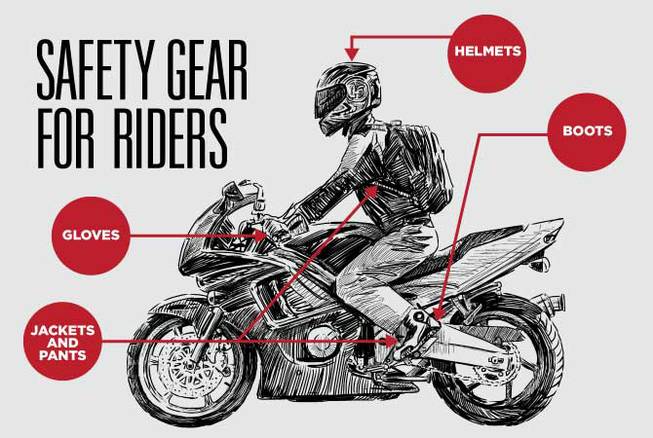
Sunday, May 10, 2015 | 2 a.m.
Wearing proper, protective gear can save motorcycle riders’ lives. Good gear simply should be part of the rider’s covenant; it’s as important as windshields, seatbelts, even doors in a car. Nevada law requires anyone on a motorcycle to wear a helmet and eye protection, but there are many other important, and possibly life-saving, pieces of equipment for motorcycle riders.
Gloves
During a crash, it’s instinct for riders to use their hands to guard themselves from falling, and durable, heavy-duty gloves can help minimize injury. Gloves made for motorcycling are created with materials that protect
the hands from road abrasion, as well as impact.
Many extend up the arm to protect the wrist, too.
Gloves also can prevent riders’ hands from getting too cold, which can happen very quickly, even in moderate temperatures. Many gloves are made to be both windproof and waterproof.
Fit tips
Gloves should fit snuggly around the wrist to ensure they don’t slide off.
Jacket and pants
Wearing a proper jacket and pants while riding can help prevent skin abrasions, broken bones and even organ damage. Look for heavy-duty, abrasion-resistant materials that are padded with body armor. The least amount of skin a rider leaves exposed while riding, the better off he or she will be in the event of a crash.
Fit tips
Heavy jackets can get hot for riders in Las Vegas, but a well-ventilated jacket can alleviate discomfort while keeping riders safe. Waterproof options are available as well.
Jackets and pants should fit snuggly to prevent armor from shifting during a crash, but they should not be excessively tight. Light-colored or reflective swatches on riding clothes make riders more visible to motorists.
Helmet
All riders in Nevada must wear a helmet and eye protection. During a crash, a quality helmet can prevent head trauma, including permanent brain damage or death. Eye protection can help ensure a rider’s vision remains intact regardless of flying road debris. A full-face helmet tends to be the most practical because it also protects the rider’s face from rocks, bugs and debris.
Fit tips
Helmets should fit snuggly but comfortably. They should not move around on the head but also shouldn’t pinch or irritate any pressure points. Generally, helmets should be replaced five years after their manufacture date or after any crash, even
if they appear to be in fine condition.
Technology for the head
Evolving technology is improving both helmet function and rider comfort. Like next-generation facewear for fighter pilots, some helmets offer a heads-up display in the helmet’s faceshield, including GPS navigation, weather updates and other helpful data, as well as wide-angle camera displays of blindspots and the rearview. Other helmets include a thermal lining that cools the head when it senses that there has been a crash. Cold can reduce brain swelling and help keep brain temperatures under fatal levels until help arrives.
Boots
Good motorcycle boots protect riders from foot and ankle injuries, provide a stable grip on footpegs and road surfaces, and can protect the rider from hot exhaust pipes. Boots also support ankles and feet, and protect against breaks and abrasions during crashes.
Fit tips
Boots should be tall enough, with good padding, to protect the ankle and have good grip and traction.

Join the Discussion:
Check this out for a full explanation of our conversion to the LiveFyre commenting system and instructions on how to sign up for an account.
Full comments policy